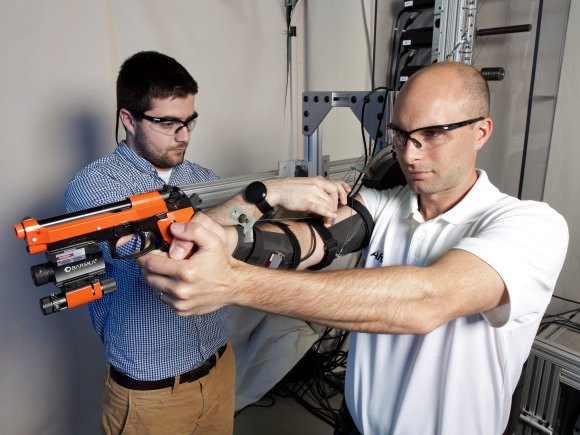US Army developing exoskeleton 'robot arms' for soldiers to improve shooting accuracy

The US Army is developing a robot exoskeleton that fits on to a soldier's arm in order to help them improve their handgun shooting accuracy on the battlefield.
Many Hollywood movies portray Americans as favouring a "just keep shooting" heavy-handed style of marksmanship, where the volume of guns and ammunition is proportionally effective in getting the job done.
Practice does make perfect, but now the US Army wants to be able to train new recruits to pick up basic shooting proficiency much faster, saving in ammunition costs. As a result, the US Army Research Laboratory (ARL) is now developing a tool to help.
The mechatronic arm exoskeleton MAXFAS is aiming to remove arm tremors that occur when a person holds a gun at arm's length, which greatly affect shooting accuracy and vary depending on the person's physical condition.
"Soldiers need to be able to aim and shoot accurately and quickly in the chaos of the battlefield," ARL mechanical engineer Dan Baechle said.
"Training with MAXFAS could improve soldiers' accuracy, and reduce current time and ammunition requirements in basic training."
How the robot exoskeleton works
The exoskeleton is inspired by a robotic device that is used at the University of Delaware to help train the arm motions of stroke victims, and the device is made from carbon fibre, which is prized for its lightweight properties.

Motors for the arm exoskeleton device are mounted behind the soldier, and these operate and pull on cables that are attached to carbon fibre arm braces wrapped around the arm.
Sensors within the braces react when they detect involuntary tremors in the arm, sending signals to the motors to correct the soldier's aim.
So far, trials of the device have shown that soldiers wearing the MAXFAS have reduced tremors in their arms, and this effect continued even after they took the device off.
Baechle admits that he has been fascinated with robot exoskeletons since he first saw the Caterpillar P-5000 Power Loader exoskeleton suit in the 1986 Sigourney Weaver film Aliens. However, the US Army is not yet close to being able to create exoskeletons like the ones seen in the more recent Iron Man films.
"My vision is that one day, a more mature version of MAXFAS could be used to improve aim on the battlefield despite any adverse conditions," he said.
"In science, we are making great progress toward making science fiction a reality."
© Copyright IBTimes 2025. All rights reserved.






















